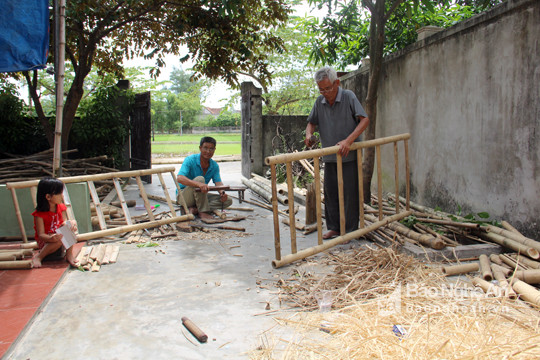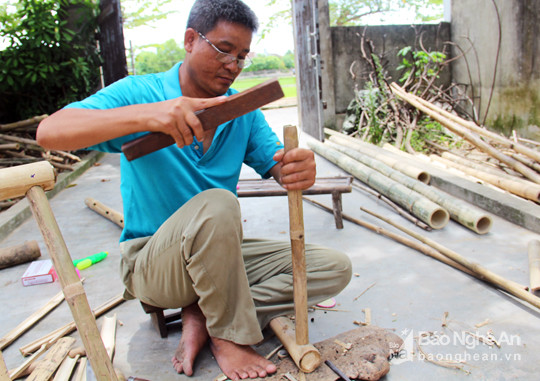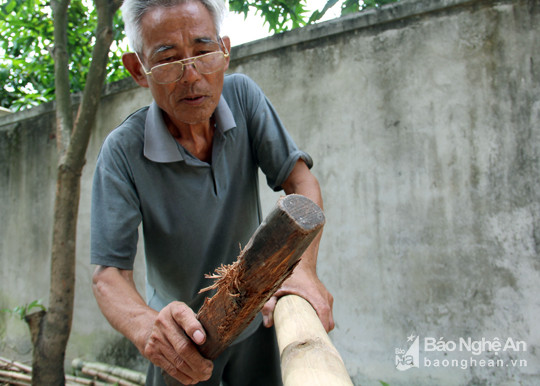Bamboo bed village in Vinh city
(Baonghean.vn) - In contrast to the bustling and dynamic streets not far away, hamlet 6, Nghi Lien commune (Vinh city) still retains rare rustic peace.
It is also the only village in the city that still preserves the craft of making bamboo beds with many skilled craftsmen.
We returned to Hamlet 6, Nghi Lien Commune when the afternoon was approaching. From afar, we could see adults and children, in groups, gathered on bamboo beds to enjoy the breeze. A peaceful scene that is hard to find in the midst of a bustling and noisy city.
In the afternoon, the occasional sound of chisels and chisels echoed. Those pleasant sounds led us to the house of Mr. Le Duy Dong, who has been making bamboo beds for more than 30 years. Notably, all three men in his family, including his father, him and his brother, are involved in the craft and have become the most skilled craftsmen in Nghi Lien.
Right at the entrance of the small house is a lot of bamboo, reed, and apricot trees. Inside, in a large yard, a man with gray hair, dark skin, and veined and calloused hands is engrossed in carving and peeling bamboo sticks to assemble into the legs of a bed.
 |
| Mr. Le Duy Dong (right) and his brother are the most skilled bed makers in hamlet 6, Nghi Lien commune. Photo: TQ |
On the other side, Mr. Dong's wife was fanning a large charcoal stove. When the charcoal was lit, she carried each bamboo stick and placed it next to the stove. Mr. Phuong then stopped working, quickly drank some water, and went to the charcoal stove. Recognizing the customer, he smiled and said: "Yesterday, I just found nearly ten bamboo sticks with old roots and solid cores, very satisfactory. Unfortunately, they were bent, so I had to burn them over fire to straighten them. I worked hard to burn and bend them, it took a little effort, but in return, I made a sturdy bed."
Having said that, he carefully heated each curved part of each bamboo. While heating, he rotated the bamboo quickly so that the outside of the bamboo would not be burnt black, then quickly placed it on the ground, one leg holding the bamboo tightly, two hands pressing hard and straightening the curved part of the bamboo. Just like that, until the bamboo was evenly straight, his back was soaked with sweat.
Making bamboo beds is a hard job, but he finds joy in that hard work. Perhaps, because the bamboo bed has been an indispensable friend since the time he held the hand while taking his first steps, until he grew up a little and helped his father make the bed; so that after each trip to the market for the bed, his mother would be rewarded with candy powder and candy pudding.
He said that at that time, the family was poor and had no beds, so the whole family slept on cots. Not even having enough money to buy a hammock for his children, his father designed a small cot and hung the four corners on the rafters. Then, he tied a rope to the window bars, and every time he lay down on the cot, he just had to pull the rope lightly and the cot would swing back and forth.
 |
| The assembly of the bed's parts is done precisely and fits perfectly. Photo: TQ |
Thus, Mr. Dong grew up following the swing of the hammock. By the age of 13, he was able to make his first hammock by himself. Although his mother immediately took the hammock to the market to sell it after it was completed, now, decades later, he can still remember and clearly describe its dimensions and every small detail related to it.
In 1986, when he had just turned 20, Mr. Dong joined the army and fought in the Cambodian battlefield. After 3 years of demobilization, he returned. Since then, after each day of farming, he has been attached to the profession of making beds.
According to him, learning how to make bamboo beds is not difficult, just need to study carefully, watch others do it and you can figure it out. However, to make a standard, durable, beautiful bamboo bed is extremely difficult. It not only requires patience, perseverance but also a little talent and dexterity. From the stage of choosing raw materials, the bed maker must have a keen eye for bamboo. Just by looking at the bamboo roots, you can know which tree is young and which tree is good to make a bed. Straight, big and plump bamboo trees are not necessarily good.
After being selected, the bamboo must be soaked in a pond before being taken out to dry, both to prevent termites and to prevent the bed from warping and cracking due to the dry weather. When making it, measuring and calculating is one part, but the important thing is to know how to estimate so that each saw and chisel must be accurate so that when assembling and connecting the bamboo sections together, they fit together tightly.
 |
| Although he is over 70, Mr. Le Duy Dong is still attached to his job. Photo: TQ |
Nowadays, when bamboo and rattan are not as abundant as before, the way of making bed-sleepers has changed somewhat. Makers can use bamboo, reed and apricot as a substitute. Depending on each material, bed-sleeper must know how to increase or decrease the thickness, tighten and shape the joints to ensure the bed is secure, the bed-sleeper legs must be sturdy, the pegs must be smooth and tight, and the knots must be smooth so that the person sitting on them will not feel pain.
Because of the meticulous care he takes in each product, Mr. Dong's "goods" are sold out as soon as they are made. On average, he sells 25 to 30 each summer month. Each bed costs about 300,000 VND, and if a customer orders a large bed, the price can go up to 700,000 - 1,000,000 VND.
During off-peak months, consumption remains stable, mainly serving the steaming and drying needs of families with small children or serving the elderly when they are seriously ill for convenient cleaning.
 |
| Bamboo beds are not only beautiful but can also be used for many years. Photo: TQ |
In many localities, preserving traditional crafts is quite difficult. However, in Hamlet 6, the craft of making beds is still preserved with nearly 20 households. Even many generations, brothers in a family make beds together and regularly innovate designs and forms to meet the increasingly high demands of customers.
For them, keeping the profession is not only about making a living, but also about the love for the traditional profession that has been passed down for hundreds of years./.
Thanh Quynh
| RELATED NEWS |
|---|

